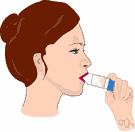al·bu·ter·ol
(ăl-byo͞o′tə-rôl′)n.
A beta-adrenergic drug, C13H21NO3, used in the form of its sulfate as a bronchodilator primarily to treat asthma and chronic obstructive pulmonary disease. Also called salbutamol.
[al(pha) + blend of but(yl) and -terol (ultimately shortening of (ar)terenol, norepinephrine hydrochloride, originally a trademark).]
American Heritage® Dictionary of the English Language, Fifth Edition. Copyright © 2016 by Houghton Mifflin Harcourt Publishing Company. Published by Houghton Mifflin Harcourt Publishing Company. All rights reserved.
albuterol
(ælˈbjuːtəˌrɒl)n
a bronchodilator used by sufferers of asthma, emphysema, and other lung conditions, to treat symptoms such as wheezing or shortness of breath
Collins English Dictionary – Complete and Unabridged, 12th Edition 2014 © HarperCollins Publishers 1991, 1994, 1998, 2000, 2003, 2006, 2007, 2009, 2011, 2014
ThesaurusAntonymsRelated WordsSynonymsLegend:
| Noun | 1. |  albuterol - a bronchodilator (trade names Ventolin or Proventil) used for asthma and emphysema and other lung conditions; available in oral or inhalant forms; side effects are tachycardia and shakiness albuterol - a bronchodilator (trade names Ventolin or Proventil) used for asthma and emphysema and other lung conditions; available in oral or inhalant forms; side effects are tachycardia and shakinessbronchodilator - a drug that relaxes and dilates the bronchial passageways and improves the passages of air into the lungs |
Based on WordNet 3.0, Farlex clipart collection. © 2003-2012 Princeton University, Farlex Inc.